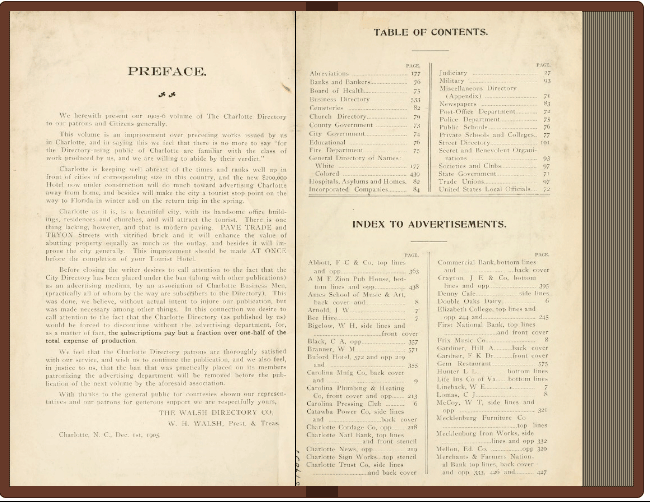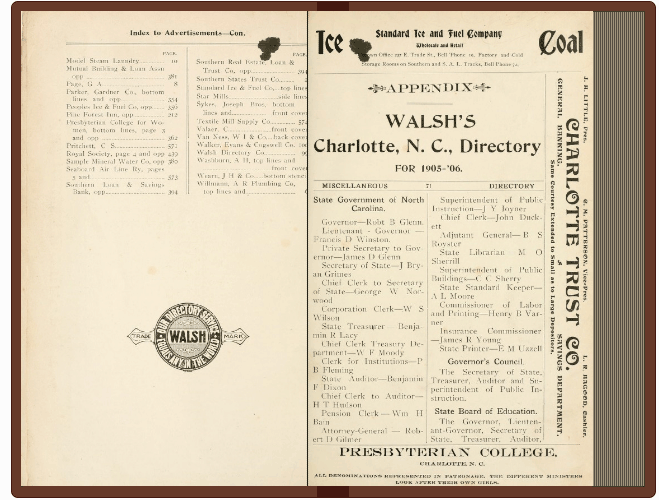Going to the Show: Lesson Plans
Explore and compare and contrast the business environment in Wilmington, North Carolina and Charlotte, North Carolina in the early 1900s by exploring the city directories
Introduction | Activity 1 | Activity 2-6 | Worksheet (pdf) | Learn More
Activity 1
Introduction
The lesson is organized into six activities that will research and gather data regarding the
business composition of Charlotte, NC, and Wilmington NC, in the early 1900s, and then two
additional activities for analysis and report-out.
- Charlotte, 1905
- Wilmington, 1905
- Charlotte, 1913
- Wilmington, 1913-1914
- Charlotte, 1920
- Wilmington, 1919-1920
- Analysis and Assessment
- Report out
To begin the discussion, let the students know that this lesson uses city directories to explain the historical business composition of two prominent North Carolina communities, Charlotte and Wilmington, in the early 1900s. Given the population and commercial growth that both cities were experiencing in the early 1900s, you might want to ask students some preliminary questions, such as what impact this growth might have on the cities, and how this growth might be manifested in the city directories.
Next, ask some questions to get students thinking and talking about city directories and using them as a historical source. Questions might include the following:
- What is the purpose of a city directory? (teachers might want to draw an analogy with a present day phone directory, or more closely, a chamber of commerce business directory)
- What information does a city directory provide? (e.g. names, addresses, phone numbers, business category)
- What is the purpose of the chamber of commerce - the publisher of the early city directories these lessons utilize?
- What goals or motivations might the chamber of commerce have behind the publishing of the city directory?
- What historical insights can you glean from a city directory?
- How can city directories across different years and from different cities be used for historical research?
You may want to note that the Wilmington city directories in the early 1900s included racial coding, designating "colored" establishments and individuals with an asterisk (*).
Activity 1: Exploring and Analyzing the 1905-1906 Charlotte city directory: 20-30 minutes (demonstration, as a class):
The next activity will explore another historical resource, the 1905-1906 Charlotte city directory. City directories are available on the Internet
Archive website. The Charlotte City Directory was published by the Charlotte Chamber of Commerce, and is reasonably analogous to a telephone directory that provides listings of government, public and commercial businesses, and proprietors and residents. The Charlotte city directory also denoted colored racial affiliations with an asterisk.
Use this activity as an introduction and orientation for the students to acquaint them with the city directories, their general composition, and the user interface features and navigation methods.
Provide students with the City Directory Worksheet so that they can record initial their initial findings as you work through the activity. Explain that this worksheet will provide a summary of the businesses you identify during your explorations.
For this lesson, you will focus on business categories that are noted in the sidebar:
A Sneak Peak at Charlotte, 1905 found in the 8th grade textbook: A Journey Through
North Carolina.
Charlotte Businesses
| Car Dealerships | 3 |
| Stables | 4 |
| Saloons | 15 |
| Drugstores | 20 |
| Restaurants | 14 |
| Hotels | 8 |
| Dairies | 7 |
| Newspapers | 13 |
| Telephone & Telegraph Companies | 5 |
| Incorporated Business | 99 |
| Cotton Mills | 12 |
| Fire Insurance Companies | 65 |
| Bicycle Repair Shops | 4 |
| Carriage and Wagon Dealers | 5 |
| Urban Manufacturers | 115 |
- Go to the 1905-1906 Charlotte City Directory website
- Select the Read Online option from the View the book block.
- There are two major navigation options to introduce: page by page or jump to a section:
- Page by page: Click on the right-facing page to advance forward a page, click on the left-facing page to advance backward a page.
Use the right arrow or left arrow found in the header space to advance page by page. - Jump to a section: Click on a relative location of the vertical "stacked pages" to move to that "section" of the book.
- Page by page: Click on the right-facing page to advance forward a page, click on the left-facing page to advance backward a page.
- Starting at the beginning of the city directory, click the right page 2 times to display the Preface for the 1905-1906 Charlotte. (Unfortunately, these initial pages are not numbered, but most of the directory does include page numbers.) The Preface is an excellent place to start, as it often provides some historical background regarding the time period.
On the facing page, you will see the Table of Contents. This will also be helpful in any city directory. A section that will be useful for these activities is the Business Directory section, which provides businesses categorically arranged and listed alphabetically by category.
What is the Chamber of Commerce's purpose in publishing this information? Who were the audiences for this publication? How might historians use this information? How should historians consider this information?

Looking above, you will see that the "Business Directory" starts on page 533.
The city directories also provide evidence of the racial segregation of the early 1900s. In the 1905 Charlotte City Directory, you might also note that the General Directory of Names (listing individuals) has been segregated into "White" and "Colored" sections. Additionally, African American businesses and individuals are denoted with an asterisk (*), as documented on the Abbreviations page.
Point your mouse about 90% through the vertical page leafs, and you should see a mouse-over hint that displays the page you're pointing at. You want to get near page 533. Page 533 provides the first page of an alphabetically listed, categorically organized listing of business categories. Page through the first few pages to explore the types of business categories, and start noting categories related to the business categories listed in the sidebar:
Page 533: (Car Dealerships) Automobiles (Dealers and Repairers) -
how many automobiles were there in North Carolina in 1905? How many automobiles
were there in 1920? (hint: page 296 of A Journey Through North Carolina)
1910: 3,000
1919: 100,000
1929: 500,000

Page 566: Stables
Page not available: Saloons - no saloons listed in the 1905-1906 city directory Business Directory section
Teacher Note:
North Carolina experienced significant alcohol prohibition pressures in the early 1900s.
This is from a "booklet" published by the Executive Committee of Anti-Saloon League, of Charlotte, N.C. (published February 4, 1908):
"On July 5th, 1904, the saloon was voted out of Charlotte by a majority of 485."
http://docsouth.unc.edu/nc/antisaloon/menu.html
Unfortunately, the Internet Archive has not yet published any Charlotte city directories between 1900 and 1904.
However, the Charlotte 1875-76 city directory is available, and can be found at:
http://www.archive.org/stream/beasleyemersonsc1875char
Refer to pages 113-114 for a list of the saloons in Charlotte at that time.
Page 541: Drug Stores (Druggists (Retail))
Page 564: Restaurants
Page 549: Hotels (What about boarding houses?)
Page 540: Dairies
Page 560, Page 83: Newspapers
Page 567: Telephone and Telegraph Companies
Page 84: Incorporated Businesses (not noted in the Business Directory section, included in front Miscellaneous Directory)
Page 559: Cotton Mills
Page 551: Fire Insurance Companies
Page 534: Bicycle Repair Shops
Page 537: Carriage and Wagon Dealers
Page not available: Urban Manufacturers - how would you go about determining this?
What other categories might reflect the economic, demographic and business composition of the community?
Also note the Miscellaneous Directory that starts on page 71:

This section opens with State Government information, followed by County Government and City Government officials. Also check the following pages:
Pages 76-78: Public Schools
Pages 79-83: Church Directory
Page 83: Libraries
If you explore the Public Schools and Church Directory sections, note that there are schools identified as "colored," and the churches are organized by both denomination / faith, and a separate section for "Colored Churches."
Introduction | Activity 1 | Activity 2-6 | Worksheet (pdf) | Learn More